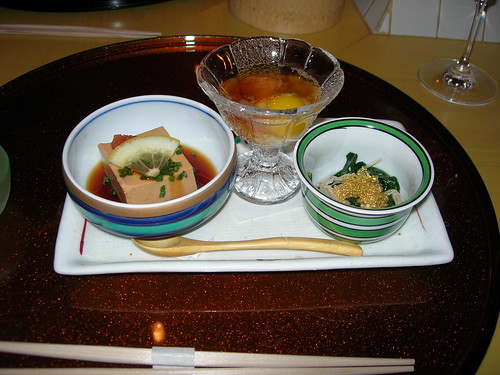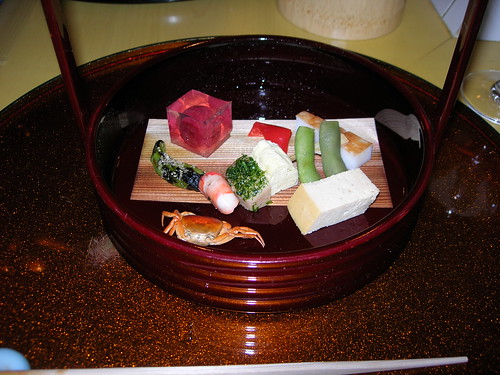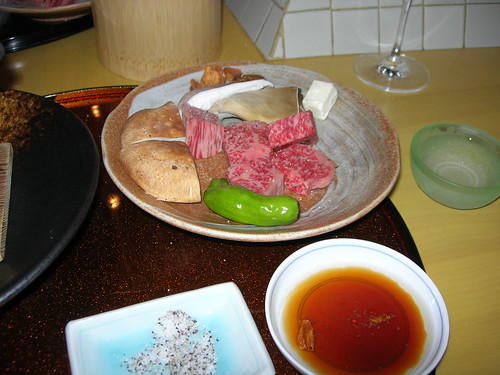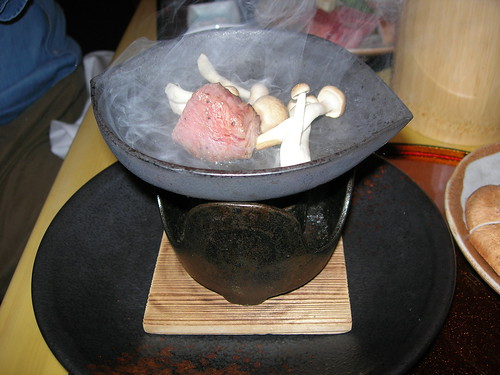Restaurants can be good or they can be grand, and the difference can be summed up in a single word: attention. Recently some friends and I ate at Sugiyama, a restaurant that is, by all accounts, one of the prime kaiseki restaurants in New York, that Japanese cuisine that channels seasonal cuisine, tied closely to market availability. Having just returned from a pair of astonishing kaiseki meals in Kyoto (at Kinmata and at Yutaka), I can report my meal that Sugiyama was quite as rapturous. In both of those wonderful Japanese meals I had the full attention of the chef. For the first I ate in my room at the lovely Kinmata ryokan (an elegant and historic Japanese inn), served by the chef; at the second a colleague and I were the only diners at a superior establishment where my companion had a connection with the proprietor.
At Sugiyama, the three of us were not dinning alone, but we held down a corner of the counter, having an up-close and personal view of the action. As one of us was a longtime friend, well-known to chef Nao Sugiyama and his staff and family, our meal was appropriately sublime. The chef was at our service, laughing, joking, gossiping, and creating a meal filled with surprise and cunning. In such a situation, one cannot generalize from the vigilant service, but the staff seemed attentive to all. If only it had been comped, I could have returned once a week to taste the chef's work as the seasons and their meals evolve! But such gratification does not come cheap. (Because the meal was off-menu and I missed some explanations my descriptions may be inexact and rough).
Sugiyama is an engaging space. It lacks the stark refinement of Masa or Sushi Yasuda or the lapidary brilliance of Jewel Bako, but it pleases. Not one of the stellar Manhattan rooms, Sugiyama has its design charms, cherry, birch, tatami, and black and white river stones abound.
To start we were presented with a trio of small appetizers, fish pate, roe with spinach, and, the last, a tactile masterpiece of sea urchin and raw quail egg to be quaffed with a smug smile of delight. The urchin and egg cocktail was sublime even if it required a touch of bravery in our age of avian flu.

These amuses were shortly followed by a severely fresh plate of sashimi - otoro, salmon, squid, kamachi (I believe this was kamachi-kama or yellowtail collar), oyster, tai (sea bream), sea urchin, scallop, and squid. These delicacies were at Tsukiji fish market yesterday and frolicking in the waves the morn before. I have never had an oyster fresher than the kumamoto oyster, a texture to which even oyster haters must admit fealty, and the otoro, kamachi, and scallop were no less distinguished. However, for me, perhaps the most startling and monumental was a little pile of spring green wasabi, a treat as fresh as the fish and so different from the contents of wasabi packets. If I cannot always judge the precise freshness of fish, the same can't be said of my wasabi. Little things can matter so much. Sugiyama wasabi is now my desired complement for matzo for Passover 2006: no more crimson horseradish at seder.
Chef Nao's third course was a panoply of small appetizers: white fish cake, omelet, tuna cake, edamame, a bit of shiso, a little fried crab that was a miniaturist's dream, and one of the night's delight, a small cube of bayberry wine jelly, surrounding a small tart fruit (peach?), what Jell-O could become in the hands of genius.

Next appeared a clear dashi soup, pure smoke and sea. Dashi is a soup stock traditionally made from kelp and bonito flakes (the latter newly arrived we were informed). Floating in this Japanese broth were little egg cakes and rice cakes, flowers and hearts. Simple, elegant, and composed with traditional art.
Now is lobster time, served with a bouquet of sea urchin roe, mushroom, red pepper, and asparagus. I admired the pure tastes of the ingredients, but confess that this was a less startling dish, not a remarkable treatment of lobster in a city whose caress of crustaceans makes it seem Kennebunkport on the Hudson.
We tucked into the chef's sushi and maki selection. I especially relished the maki that combined shrimp and cucumber. The lovely bonito was a delightful treat. Yet, truly unforgettable was a simple pile of fresh bamboo that was to be dipped in a tart yuzu sauce.
Then kobe-style beef (from a Japanese owned-ranch in Texas, I believe). To ogle a cube of "kobe" is to understand the meaning of marbled. Lines of red and white composed what might have been a Jackson Pollock production, had the Dripper been as enamored of protein as he was of pigment. On a heated iron bowl we placed mushrooms, pepper, and cubes of meat worth their weight in truffle. The doneness was left to each of us, and when my internal clock was ticking the melting meat was cow-butter. The additional butter pat was what Thorstein Veblen might have derided as gustatory emulation had he encountered the Japanese leisure class.


Unlike Western meals, Japanese dinners slide to a close without explosions of caloric luxury. We received a palate cleanser: a subtle mushroom soup, served with a rice, vegetable, and fish mixture, served in a traditional leaf (reminiscent of fine dim sum) and pickled vegetables. Finally appeared a gift of grapefruit compote in wine jelly - sweet, sour, and creamy. At Japanese restaurants there is no tradition of pastry chef: one meal, one chef.
Perhaps other diners at Sugiyama will not be treated to a dinner of such precise calibration. Yet, the basic structure of Chef Nao's kaiseki meal will surely be recognizable by others. And if, like us, one sits at the counter, the show of artistry deepens one's appreciation of a meal in which a chef's performance is as aesthetic as the product. At many Western restaurants a chef can train assistants to carry out the tasks of cooking while s/he travels, promoting the brand. Such a division of labor is hardly possible in a culture in which the doing of perfection is at the heart of cuisine, techniques that reach for eternity. An absent chef is no chef at all.
Sugiyama
251 W. 55th Street (at 8th Avenue)
Manhattan (Midtown)
212-956-0670

No comments:
Post a Comment